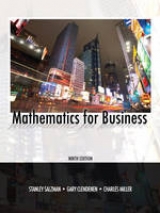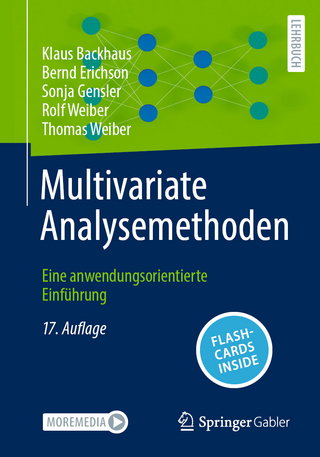
Mathematics for Business
Pearson (Verlag)
978-0-321-35743-4 (ISBN)
- Titel erscheint in neuer Auflage
- Artikel merken
The Eighth Edition of Mathematics for Business continues to provide solid, practical, and current coverage of the mathematical topics students must master to succeed in business today. The text begins with a review of basic mathematics and goes on to introduce key business topics in an algebra-based context.
Chapter 1, Problem Solving and Operations with Fractions, starts off with a section devoted to helping students become better problem solvers and critical thinker while reviewing basic math skills. Optional scientific calculator boxes are integrated throughout and financial calculator boxes are presented in later chapters to help students become more comfortable with technology as they enter the business world. The text incorporates applications pertaining to a wide variety of careers so students from all disciplines can relate to the material. Each chapter opener features a real-world application.
Table of Contents:
(Each chapter is followed by a Quick Review of terms, Chapter Concepts, Review Exercises, a Summary Exercise, and a `Net Assets exercise.)
PART I. BASIC MATHEMATICS
1. Problem Solving and Operations with Fractions
1.1 Problem Solving
1.2 Addition and Subtraction of Fractions
1.3 Multiplication and Division of Fractions
2. Equations and Formulas
2.1 Solving Equations
2.2 Applications of Equations
2.3 Formulas
2.4 Ratios and Proportions
3. Percent
3.1 Writing Decimals and Fractions as Percents
3.2 Finding the Part
3.3 Finding the Base
3.4 Supplementary Exercise: Base and Part
3.5 Finding the Rate
3.6 Supplementary Exercise: Rate, Base, and Part
3.7 Increase and Decrease Problems
Cumulative Review, Chapters 1-3
PART II. BASIC BUSINESS APPLICATIONS
4. Banking Services
4.1 Checking Accounts and Check Registers
4.2 Checking Services and Depositing Credit Card Transactions
4.3 Reconciliation
5. Payroll
5.1 Gross Earnings (Wages and Salaries)
5.2 Gross Earnings (Commission)
5.3 Gross Earnings (Piecework)
5.4 Social Security, Medicare, and Other Taxes
5.5 Income Tax Withholding
5.6 Payroll Records and Quarterly Returns
6. Taxes
6.1 Sales Tax
6.2 Property Tax
6.3 Personal Income Tax
7. Risk Management
7.1 Business Insurance
7.2 Motor Vehicle Insurance
7.3 Life Insurance
Cumulative Review, Chapters 4-7
PART III. MATHEMATICS OF RETAILING
8. Mathematics of Buying
8.1 Invoices and Trade Discounts
8.2 Single Discount Equivalents
8.3 Cash Discounts: Ordinary Dating Method
8.4 Cash Discounts: Other Dating Methods
9. Markup
9.1 Markup on Cost
9.2 Markup on Selling Price
9.3 Markup with Spoilage
10. Markdown and Inventory Control
10.1 Markdown
10.2 Average Inventory and Inventory Turnover
10.3 Valuation of Inventory
Cumulative Review, Chapters 8-10
PART IV. MATHEMATICS OF FINANCE
11. Simple Interest
11.1 Basics of Simple Interest
11.2 Simple Interest for a Given Number of Days
11.3 Maturity Value
11.4 Inflation and the Time Value of Money
12. Notes and Bank Discount
12.1 Simple Interest Notes
12.2 Simple Discount Notes
12.3 Comparing Simple Interest and Simple Discount
12.4 Discounting a Note.
13. Compound Interest
13.1 Compound Interest
13.2 Daily and Continuous Compounding
13.3 Finding Time and Rate
13.4 Present Value at Compound Interest
14. Annuities and Sinking Funds
14.1 Amount of an Annuity
14.2 Present Value of an Annuity
14.3 Sinking Funds
15. Business and Consumer Loans
15.1 Open-End Credit
15.2 Installment Loans
15.3 Early Payoffs of Loans
15.4 Personal Property Loans
15.5 Real Estate Loans
Cumulative Review, Chapters 11-15
PART V. ACCOUNTING AND OTHER APPLICATIONS
16. Depreciation
16.1 Straight-Line Method
16.2 Declining-Balance Method
16.3 Sum-of-the-Years'-Digits Method
16.4 Units-of-Production Method and Partial-Year Depreciation
16.5 Modified Accelerated Cost Recovery System
17. Financial Statements and Ratios
17.1 The Income Statement
17.2 Analyzing the Income Statement
17.3 The Balance Sheet
17.4 Analyzing the Balance Sheet; Financial Ratios
18. Securities and Distribution of Profit and Overhead
18.1 Distribution of Profits in a Corporation
18.2 Buying Stock
18.3 Bonds
18.4 Distribution of Profits and Losses in a Partnership
18.5 Distribution of Overhead
19. Business Statistics
19.1 Frequency Distributions and Graphs
19.2 The Mean
19.3 The Median and the Mode
19.4 Range and Standard Deviation
19.5 Index Numbers
Cumulative Review, Chapters 16-19
Appendix A: Calculator Basics
Scientific Calculators
Financial Calculators
Appendix B: The Metric System
Appendix C: Powers of e
Appendix D: Interest Tables
Answers to Selected Exercises
Glossary
Index
| Erscheint lt. Verlag | 17.8.2006 |
|---|---|
| Sprache | englisch |
| Maße | 224 x 263 mm |
| Gewicht | 1954 g |
| Themenwelt | Mathematik / Informatik ► Mathematik ► Finanz- / Wirtschaftsmathematik |
| ISBN-10 | 0-321-35743-4 / 0321357434 |
| ISBN-13 | 978-0-321-35743-4 / 9780321357434 |
| Zustand | Neuware |
| Haben Sie eine Frage zum Produkt? |
aus dem Bereich



